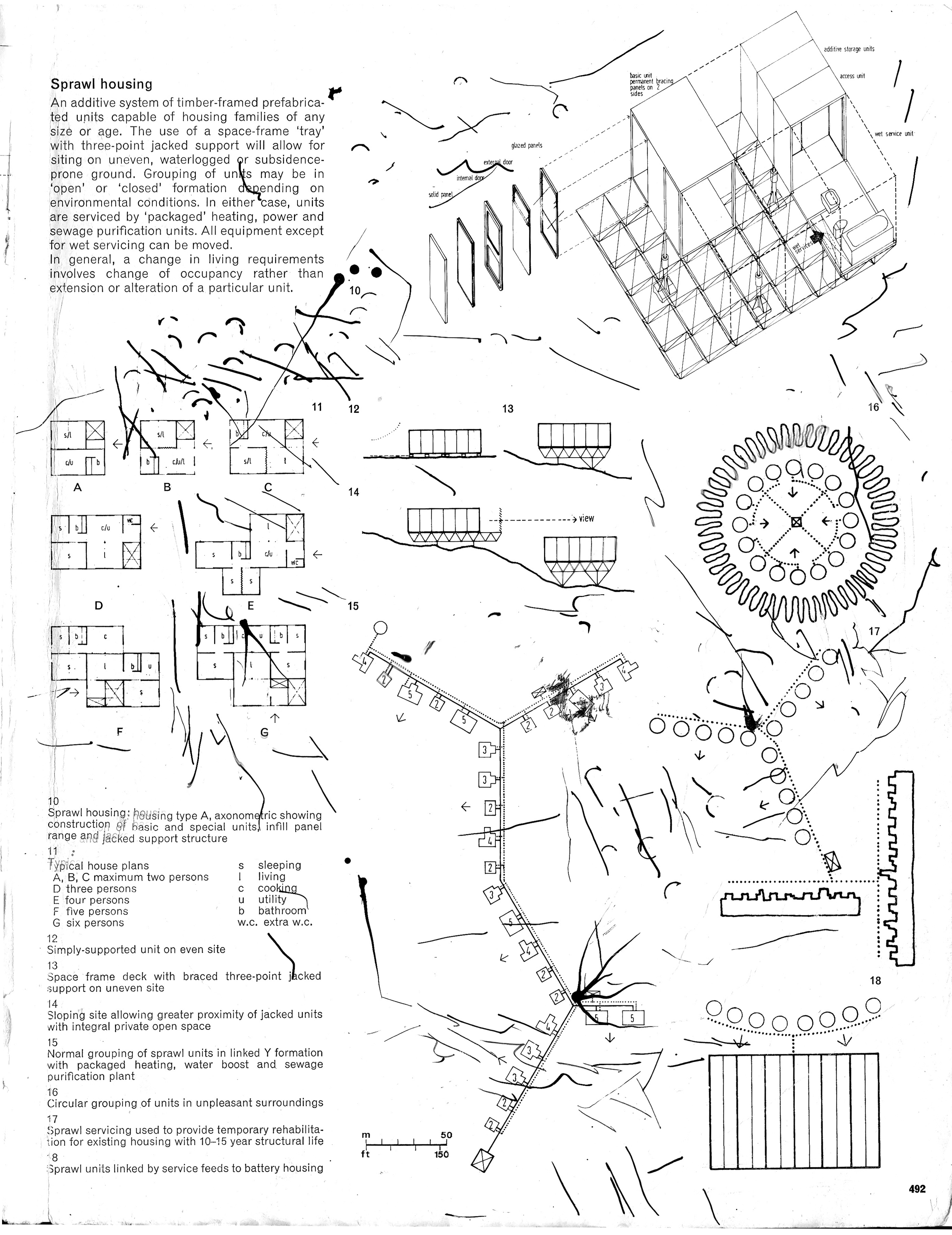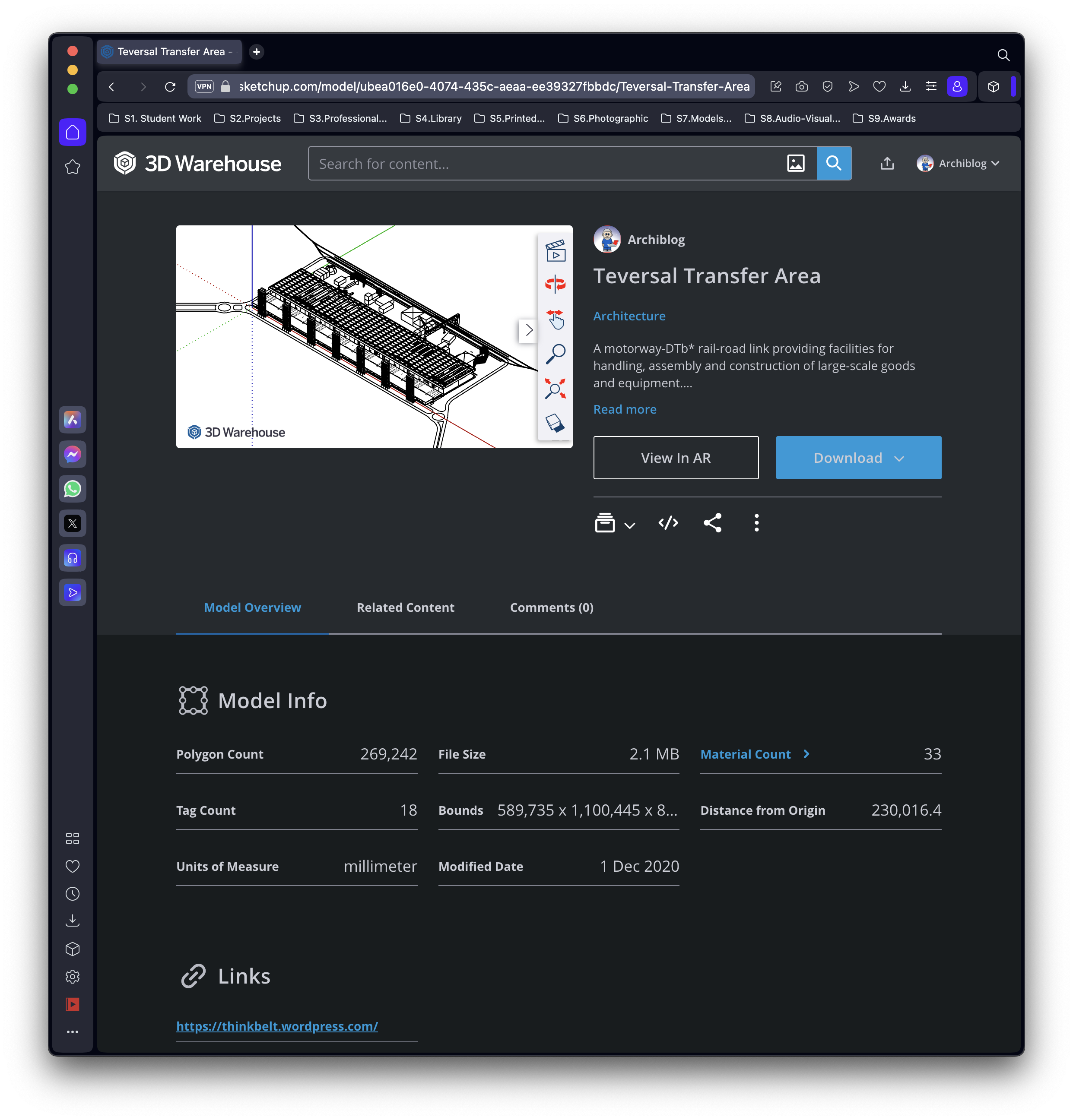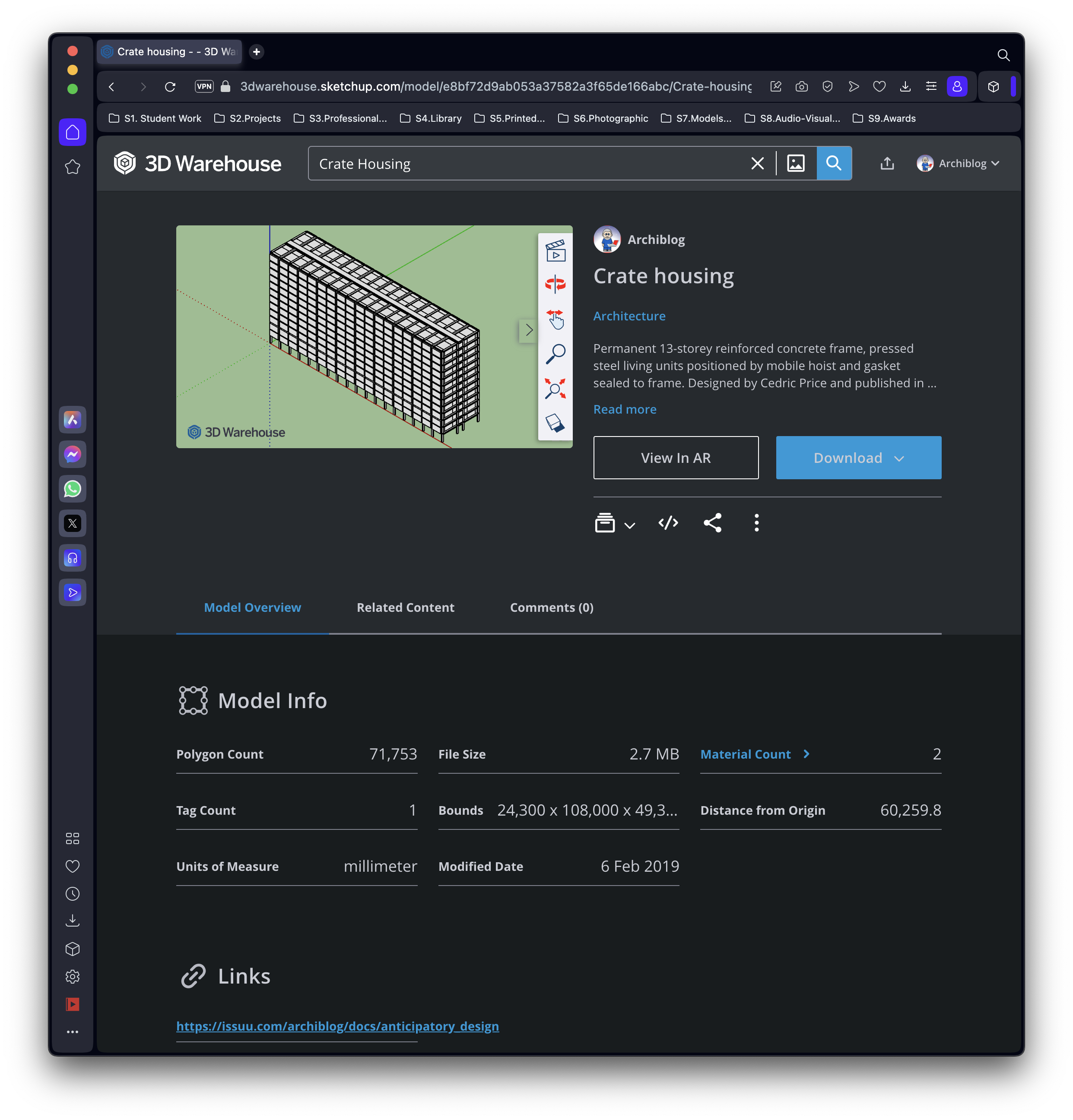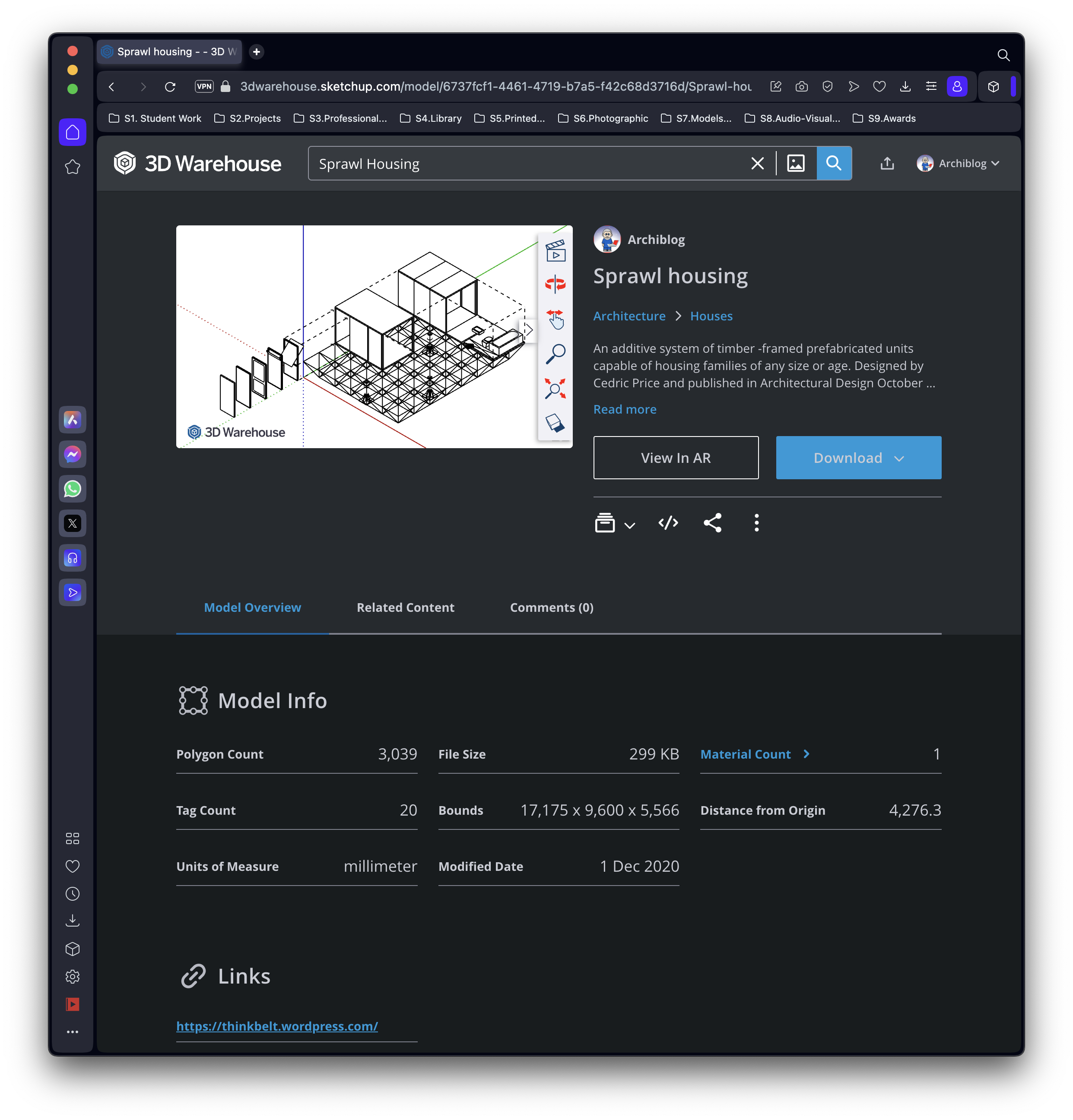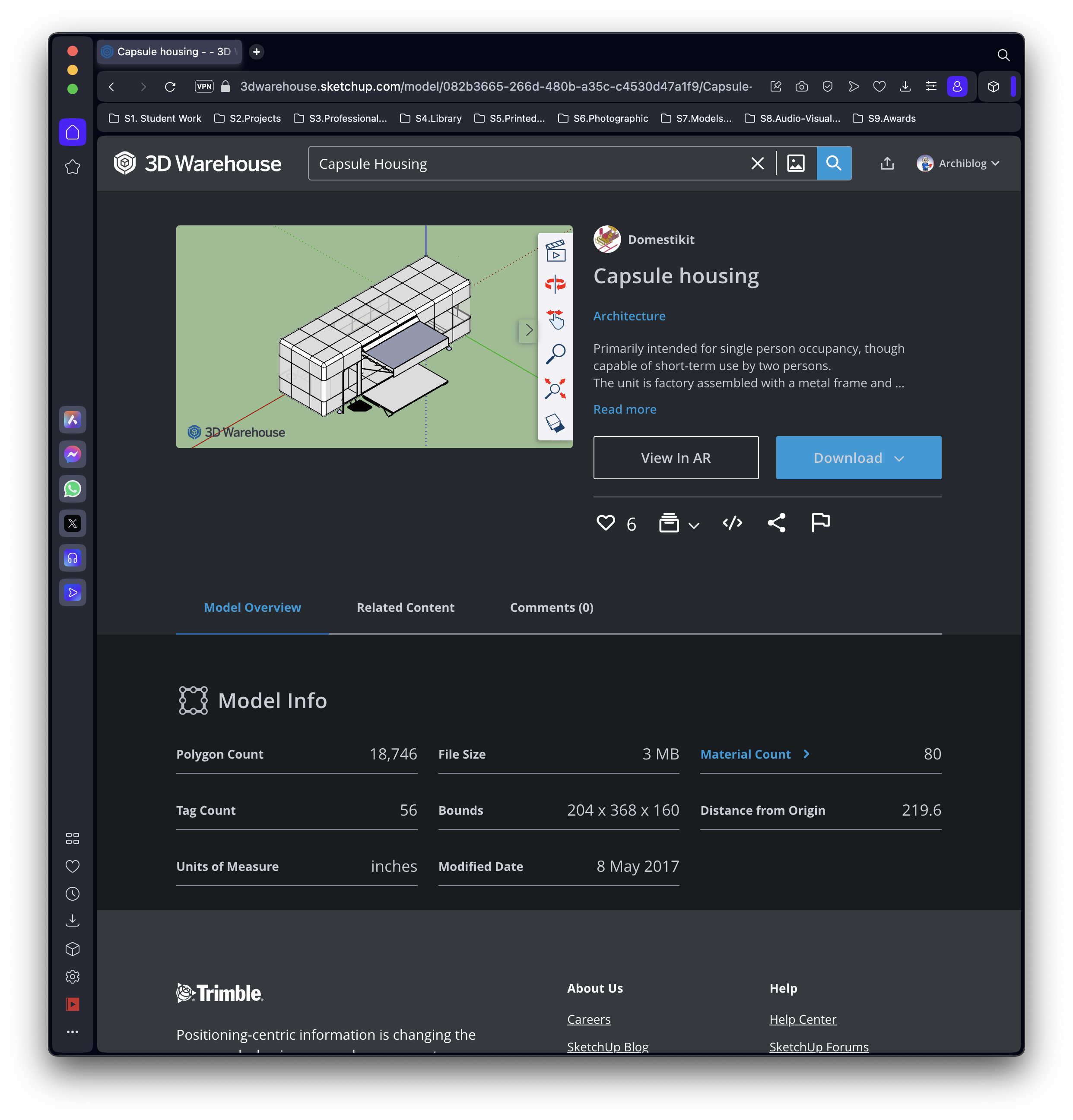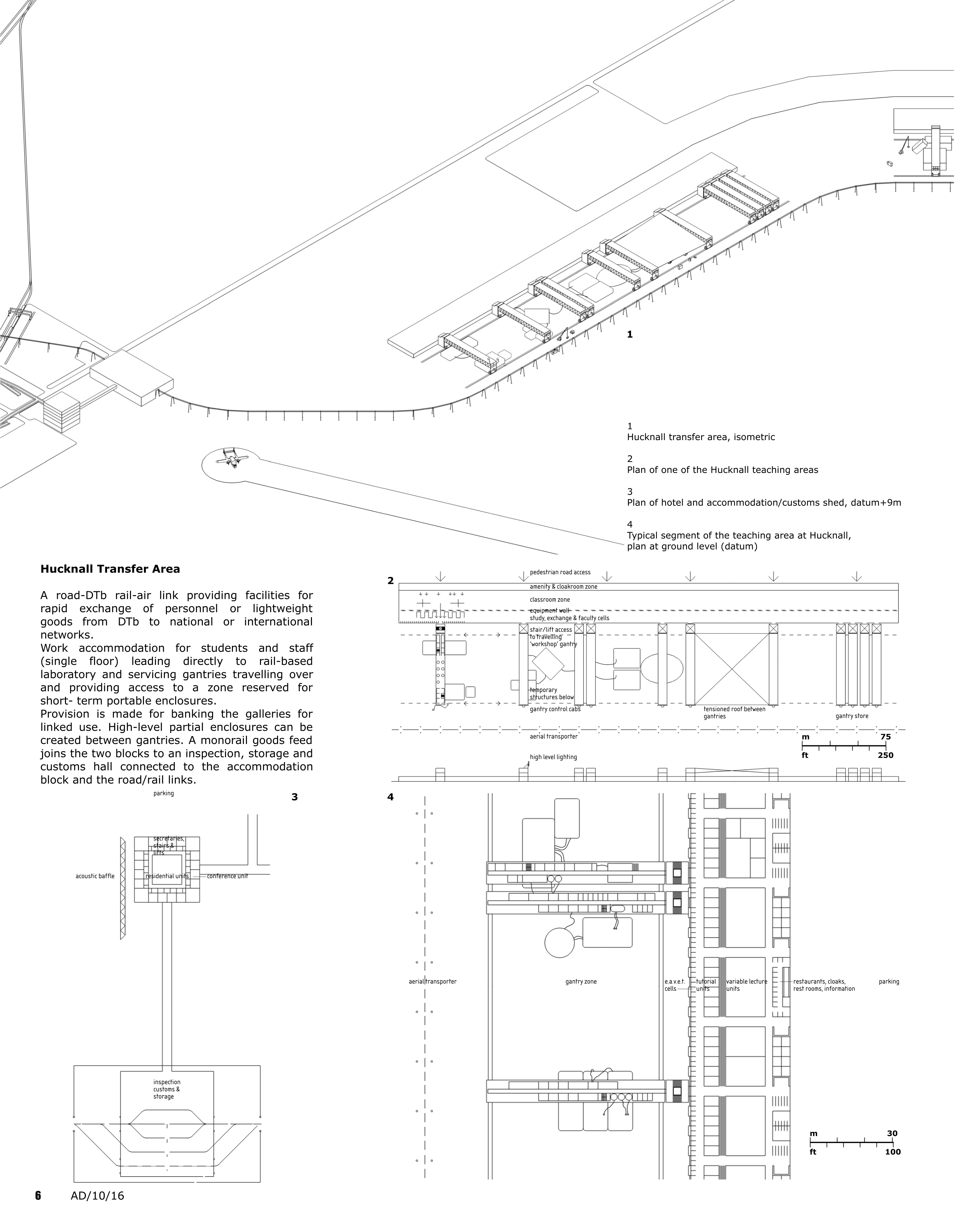Potteries Thinkbelt study
|
|
[edit] FOREWORDIn February 1966, Cedric Price completed a report, namely:—
Copies of the report—an unpublished manuscript—are held in the Cedric Price fonds, at the Canadian Centre for Architecture (CCA), in Montréal, Canada, where they can only be viewed by appointment. They are also unavailable on the CCA website. Nevertheless the purpose of this article on the Designing Buildings website is:—
(* Cedric Price's preferred term) |
[edit] INTRODUCTION
Firstly, in June 1966, Cedric Price published an article in New Society entitled 'Potteries Thinkbelt', in which he wrote:—
- "This Thinkbelt study helps to indicate a valid national and regional distribution of educational institutions."
- (p.14)
Thus Cedric Price assumed a need, namely:—
- to indicate a valid national and regional distribution of educational institutions;
and proposed a hypothetical solution, namely:—
- a Thinkbelt study.
Secondly, in October 1966, Cedric Price published an article in Architectural Design entitled "PTb", in which the assumed need and the hypothetical solution in the New Society article were combined into one whole:—
- "This study proposes a valid national and regional distribution of educational institutions."
- (p.484)
Thirdly, in July 2024, Norman Fellows published this article on the Designing Buildings website, in which he assumes:—
- ... that in order to propose a valid national and regional distribution of educational institutions in 1965 Cedric Price constructed a 'working hypothesis'. [1] [2]
Thus this article provisionally accepts the working hypothesis constructed by Cedric Price—i.e. Potteries Thinkbelt study—as a basis for further ongoing research.
[edit] FACSIMILES
[edit] • (1) The Thinkbelt study published in New Society
Cedric Price picked out a point made by Herbert Haslegrave about the need to use temporary structures:—
- "The priorities in education are staff, equipment and buildings—in that order."
- (Herbert Haslegrave, Letter to The Times, 1965) [3]
According to Herbert Haslegrave:—
- "...the choice is between the solid and permanent or the demountable and temporary. If well designed, sited and landscaped, temporary buildings can look attractive and almost everything can be taught and studied in them."
- "...education is in such a state of flux—it always is—and it is so subject to the effects of changing educational, philosophical, sociological and political ideas, as well as to economic crises (that it was only sensible for the) buildings to be adaptable."
|
• Table 1: Facsimile of the Potteris Thinkbelt article published in New Society, 2 June 1966.
[edit] • (2) The Thinkbelt study published in Architectural Design
- "Cedric Price's revolutionary proposal is that advanced education—and in particular advanced technical education—should become the new prime industry."
- (Robin Middleton, Introduction to the PTb, AD/10/66, p.483) [4]
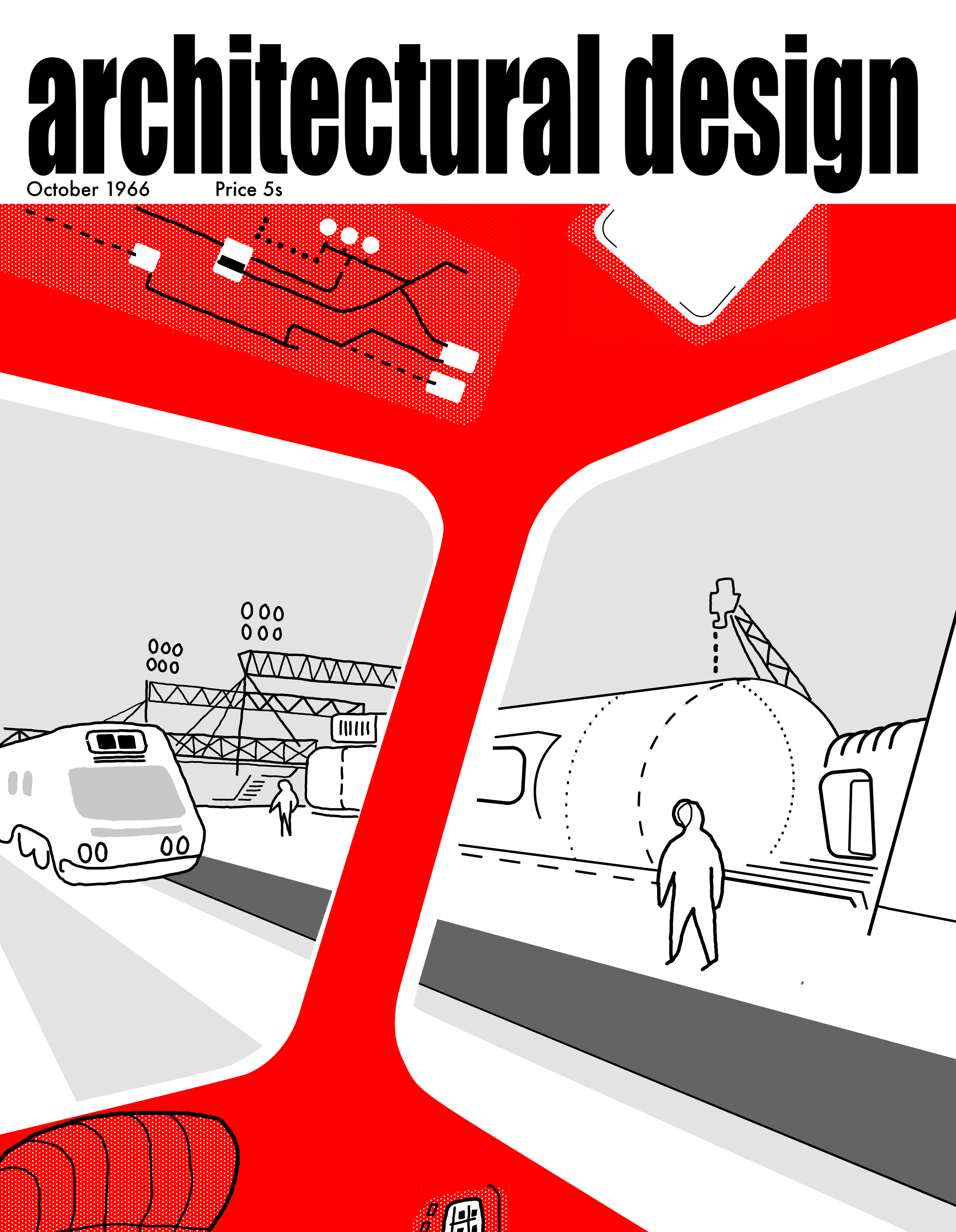
|
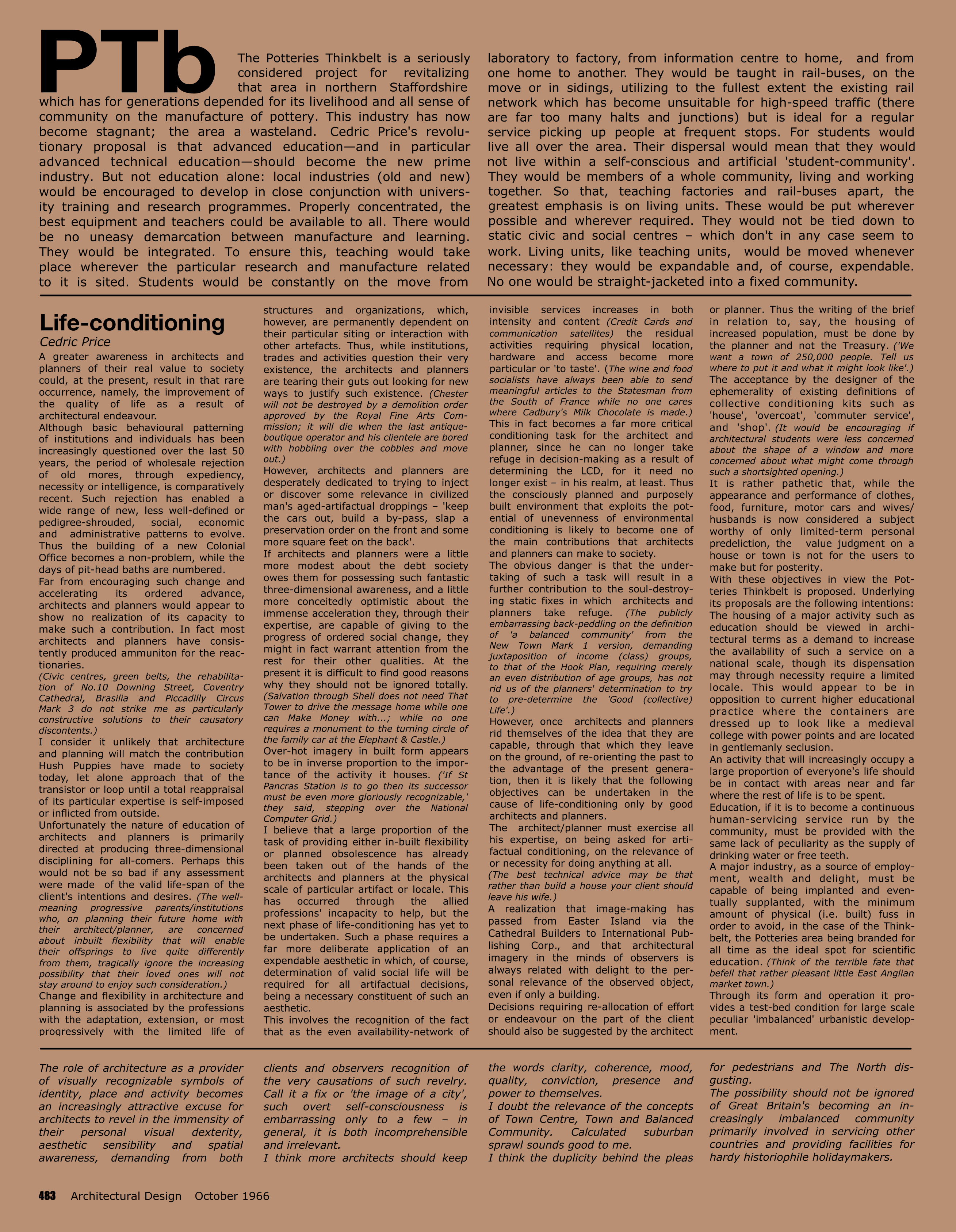
|

|

|

|

|

|

|

|

|

|

|

|

|

|

|
• Table 2: Facsimile of the PTb article published in Architectural Design, October 1966.
Underlying the Potteries Thinkbelt's proposals were the following intentions:—
- "The housing of a major activity such as education should be viewed in architectural terms as a demand to increase the availability of such a service on a national scale, although its dispensation may through necessity require a limited locale.This would appear to be in opposition to current higher educational practice where the containers are dressed up to look like a medieval college with power points and are located in gentlemanly seclusion."
- "An activity that will increasingly occupy a large proportion of everyone's life should be in contact with areas near and far where the rest of life is spent."
- "Education, if it is to become a continuous human servicing service run by the community, must be provided with the same lack of peculiarity as the supply of drinking water or free teeth."
- "A major industry, as a source of employment, wealth and delight, must be capable of being implanted and eventually supplanted, with the minimum of physical (i.e. built) fuss in order to avoid, in the case of the Thinkbelt, the Potteries being branded for all time as the ideal spot for scientific education. (Think of the terrible fate that be fell that rather pleasant little East Anglian market town.)"
- "Through its form and operation it provides a test-bed condition for large-scale peculiar 'imbalanced' urbanistic development."
- (Life-conditioning, p.483).
The first paragraph of the PTb article was an assertion, namely:—
- "The prime weakness of the advanced educational system in Britain is a lack of awareness of both the correct scale and intensity at which such education should occur."
- (PTb, p.484).
The second paragraph began with another assertion, namely:—
- "Institutions today are too small and too exclusive."
- (ib.).
and then explained:—
- "Because advanced education is not regarded as a major national industry, it is in danger of failing to achieve both a social relevance and a capacity to initiate progress rather than an attempt to catch up with it".
- (ib.)
[edit] FINDING AIDS
- "The only purchaser of the full Potteries Thinkbelt documentation was the Ministry of Housing and Local Government who bought the report and copies of every single drawing including the photo-montages."
- (Royston Landau, 1984)
In 1995, however, the full documentation was also purchased from Cedric Price Architects by the CCA where it is archived. The Potteries Thinkbelt file includes:—
- 192 reprographic copies
- 190 drawings
- 3 panels
- 0.15 l.m. of textual records
- 0.04 l.m. of photographic materials
- (Potteries Thinkbelt, CCA, 1995-2006)
The CCA has a set of finding aids, one of which links to Cedric Price fonds. However, the link below provides access via hyperlinks to 52 digitized items archived in the Pottteries Thinkbelt file at the CCA.
In addition, 7 drawings and 3 photo-montages can be found in a collection of CP's works at MOMA in Manhattan:—
[edit] ITERATIONS
- "For some years, AD has been publishing schemes, articles and comments by Cedric Price as one of the prime movers on the radical architecture scene. However, much of this work still remains unpublished and much of the published work requires rethinks and updated commentaries."
- (Peter Murray, Introduction to the Cedric Price Supplement, AD/10/70, p.507) [5]
[edit] • (1) Cedric Price Works II
In 1984, CP published a book entitled 'Cedric Price Works II' in which he wrote:—
- "...the challenge from the Junior Government Minister, Lord Kennet, to explain an alternative to the then popular 'new' universities (early sixties) produced the Potteries to take advantage of local unemployment, a stagnant local housing programme, a redundant rail network, vast areas of unused, unstable land, consisting mainly of old coal-working and clay pits, and a national need for scientists and engineers. At the time, though not built, its ideas were heeded by both the UK and US Administrations because, I think, of its immediacy in response to a known situation. It is ironic that the response of other architects at the time, 1963, was totally hostile while now twenty years later - the period proposed for its socio-economic life - architects find it 'interesting' and 'important'!"
- (From the introduction to the chapter entitled 'ACTION and inaction', p.18) [6]
The book republishes the entire 'Life-conditioning' essay from AD/10/66 together with a trimmed copy of Drawing Number 64/34—"initial plan of entire PTb scheme".
It also republishes the diagram and montages from p.486; edited versions of the transfer areas from pages 487 to 489; and edited versions of the housing types from pages 491 to 494.
|
In April 1980, CP wrote 'Memorandum on universities' which is included in the sidebar on page 23:—
|
• Reprographic copy of initial plan of entire PTb scheme, archived at MOMA, courtesy of The Howard Gilman Foundation. |
• Additional material
[edit] • (2) Supercrit #1 Cedric Price POTTERIES THINKBELT
In 2003, CP planned a 'Supercrit', together with Samantha Hardingham and Paul Finch. When he was asked if he would consider presenting the Potteries Thinkbelt at the first Supercrit, CP reportedly asked one question, namely:—
- "what is the value of it now - what is useful about it now, for you?"
- (quoted in 'Supercrit #1: Cedric Price: POTTERIES THINKBELT', 2007)

|
• Screenshot: Poster advertising Supercrit #1 and others.
In 2007, Samantha Hardingham and Kester Rattenbury published the book entitled 'Supercrit #1: Cedric Price: POTTERIES THINKBELT'. It contained:—
- a transcript of Supercrit #1 (the event in November 2003);
- photographs from the exhibition and of the participants;
- pages of New Society, reproduced from the issue of 2 June, 1966, pp.14-17;
- 6 Project illustrations;
- the 'Life-conditioning' essay;
- pages of Architectural Design, reproduced from the issue of October 1966, pp.483-497;
- a transcript of CP speaking at the Potteries Thinkbelt exhibition in Madrid in 2002.
|
• "The scarred landscape of North Staffordshire Potteries c.1963" |
• "...every single bit of kit was drawn on the aerial survey with cast shadows" (Stephen Mullin. p.83) |
• "Madeley transfer area" |
• "Preliminary sketch" |
• Project illustrations from the book

|

|
• Transcript from the book of CP speaking at the Potteries Thinkbelt exhibition in Madrid in 2002. Retyped by Norman Fellows.
In the 'Preview', Samantha Hardingham had written:—
- "...the POTTERIES THINKBELT study (Price's preferred word) serves as a useful primer for looking at much of his other work."
- (p.11)
However, in the 'Review', Kester Rattenbury wrote:—
- "Some things about the POTTERIES THINKBELT which became very clear – and maybe this is why Cedric chose this project – was its relevance today. This was, as Cedric himself pointed out in The Square Book, ironic, given that this was the time in which, had it been built, it would have been operating. Time was ever a critical medium on Cedric's proposals, and on the day of the Supercrit, it was really clear just how long-range, well worked out, prescient the PTb was. It pre-anticipated a post-industrial countryside - though Stoke was, in 1966, a very rare example of the social and physical wrecking power of industry in decline. It anticipated a boom in education - already in progress, but it anticipated the broader, more lateral and much later bits of it: the Open University, access to university for all, life-long learning - and proposed a different version for all of them. It assumed the need for integrating housing, employment, education, transport, leisure, amenity – in a way which still has not been realised. And beyond that, it insisted that all this should be flexible so as to respond to further change - the change of the next 40 years, after that."
- (ib., pp.124-125)
[edit] FURTHER ONGOING RESEARCH
The further ongoing research cited in the chronological table below is based on the working hypothesis constructed by Cedric Price in 1965:—
• August 1967: Architectural Design, October 1966, received from Walsall Borough Architects. [7]
• January 1979: Facsimile of panel discussed with Cedric Price together with the Potteries Thinkbelt study above. [8]
• March 1984: Facsimile of preparatory map of the DTb showing main routes, transfer, faculty and housing areas. [9]
• 2011-2014: Models of transfer areas and mobile learning units, Edukit, 3D Warehouse. [10]
• March 2015: Textual records submitted to 2015 Buckminster Fuller Challenge. [11]
• March 2015: Panel submitted to 2015 Buckminster Fuller Challenge. [12] • 2016: Models of housing types, Archiblog, 3D Warehouse. [13]
• 2016: Facsimile of New Society article entitled 'Dukeries Thinkbelt', October. [14]
• 2016: Facsimile of Anticipatory Design article entitled 'DTb'.October. [15]
• May 2018: Panel outlining the Dukeries Thinkbelt study 2015. [16]
• November 2023: Animated video based on the drawings of Dukeries Thinkbelt by Norman Fellows [17] |
[edit] CONCLUSION
This article accepts the working hypothesis constructed by Cedric Price—i.e. Potteries Thinkbelt study—as a basis for further ongoing research.
For example, in May 1969, Cedric Price published an article in Architectural Design entitled 'Non-plan' in which he made a key proposal, namely:—
- "Possible Thinkbelt development in old industrial net between Nottingham and Sheffield 30—40 miles (i.e. half length of Los Angeles)"
- (Cedric Price, Non-plan, AD 5/69, p.270)
Thus this article concludes:—
- ... that the Potteries Thinkbelt study anticipated a future research and development programme.
|
• Screenshot of New DTb website before its launch In February 2026. • Collage: Clipping mounted on General Reference Map of the East Midlands. |
• Images indicating possible further ongoing research and "a test-bed for large-scale peculiar 'imbalanced' urbanistic development" (after Cedric Price, AD/10/66)
[edit] Notes
[1] According to the CCA, the predominant dates of the creation of Potteries Thinkbelt were 1963-1967.
[2] The term 'working hypothesis' may be defined as follows:—
- "A working hypothesis is a hypothesis that is provisionally accepted as a basis for further ongoing research in the hope that a tenable theory will be produced, even if the hypothesis ultimately fails. Like all hypotheses, a working hypothesis is constructed as a statement of expectations, which can be linked to deductive, exploratory research in empirical investigation and is often used as a conceptual framework in qualitative research. The term "working" indicates that the hypothesis is subject to change."
- (Wikipedia)
[3] "In 1953 (Herbert Haslegrave) became Principal of Loughborough College and developed it into a College of Advanced Technology in 1957 and to the UK's first Technical University, Loughborough University of Technology in 1966." Wikipedia.
[4] "(Robin) Middleton was technical editor of Architectural Design from 1964 to 1972...", Wikipedia.
[5] Murray, P. (1970) 'Introduction', Cedric Price Supplement, Architectural Design, June.
[6] Drawing Number 64/100—'Chart of life span and use cycle'—indicates the expected socio-economic life of the Potteries Thinkbelt.
[7] August 1967, this copy of Architectural Design, October 1966, was given to Norman Fellows.
[8] Jan 1977 - December 1978, Norman Fellows created a preliminary design for Domestikit.
[9] 1981-1984 - Preparatory work on the Dukeries Thinkbelt - a self-sponsored project by Norman Fellows.
[10] 2011-2014 SketchUp drawings used in Edukit submission and Dukeries Thinkbelt, self-published in AD/10/16 by Norman Fellows.
[11] March 2015 - Textual records as part of Edukit submission to 2015 Buckminster Fuller Challenge by Norman Fellows.
[12] March 2015 - Panel presenting Edukit catalogue as part of Edukit submission to 2015 Buckminster Fuller Challenge by Norman Fellows.
[13] 2011-2014 SketchUp drawings used in Facsimile 2; and in Dukeries Thinkbelt, self-published AD/10/16 by Norman Fellows.
[14] In June 2016, Norman Fellows self-published Dukeries Thinkbelt in a facsimile of New Society.
[15] In October 2016, Norman Fellows self-published DTb in a facsimile of Anticipatory Design.
[16] 2018, Panel presenting the Dukeries Thinkbelt study by Norman Fellows to the Labour Party Policy Forum.
[17] In November 2023, Norman Fellows created an animated video based on the drawings of Dukeries Thinkbelt.
[edit] References
Canadian Centre for Architecture (1995) 'Potteries Thinkbelt', Cedric Price fonds, Canadian Centre for Architecture.
East Midlands Economic Planning Council (1966) ‘The East Midlands Study’, HMSO.
Hardingham, S. and Rattenbury, K (2007) 'Cedric Price: Potteries Thinkbelt - Supercrit #1', Routledge.
Landau, R. (1985) ‘Philosophy of enabling: The work of Cedric Price‘, AA Files, No. 8, January, pp. 3-7 – also in Price, C. (1984) ‘Cedric Price Works II’, Architectural Association, pp. 9-15.
Price, C. (1966) 'Potteries Thinkbelt: A plan for the establishment of a major advanced educational industry in North Staffordshire', February.
Price, C. (1966) ‘Potteries Thinkbelt‘, New Society, 2 June, on WordPress.
Price, C. (1966) ‘PTb‘, Architectural Design, October - also available on thinkbelt.wordpress.com
Price, C. (1969) ‘Non-Plan’, Architectural Design, May, Wordpress.
Price, C. (1984) 'Cedric Price Works II', Architectural Association - reprinted and republished in 2003 as 'Cedric Price - The Square Book'.
Roth, M (2014) 'Introduction: Social Good and Tragedy of the Commons', Wesleyan University.
[edit] Further reading
Banham, R., Barker, P., Hall, P. and Price, C. (1969) ‘Non-Plan: An Experiment in Freedom’, New Society, 20 March.
Fellows, N. (2007 et seq.) 'Archiblog', YouTube.
Fuller, R. B. (1962) 'Education Automation'
Fuller, R. B. (1963) 'Ideas and Integrities'
Landau, R. (1968) 'New Directions in British Architecture', pp.76-86, Studio Vista, London - free to access on the Internet Archive.
Levin, A. J. (23 June 2011) ‘Potteries Thinkbelt – Education, Architecture and a Way Forward‘, Sputnik Shuffle.
Mathews, S. (2007) 'Potteries Thinkbelt', Chapter 7 in 'Cedric Price: From the ‘Brain Drain’ to the ‘Knowledge Economy’', black dog publishing.
Price, C. (1971) 'Cedric Price Supplement No.4', Architectural Design, October.
Price, C. (1972) 'Cedric Price Supplement No.5', Architectural Design, January.
Robbins Committee (1963) 'The Robbins Report', HMSO.
[edit] Related articles on Designing Buildings
ATOM: A generating system designed by Cedric Price
Beeching cuts: The railway network in Nottinghamshire
Disaster Planning: North Staffs
EDUKIT: World Educational System
Housing Research by Cedric Price
Miners' Strike: The coal industry in Nottinghamshire
--Archiblog 07:16, 04 Jul 2024 (BST)
Featured articles and news
Gregor Harvie argues that AI is state-sanctioned theft of IP.
Preserving, waterproofing and decorating buildings.
Many resources for visitors aswell as new features for members.
Using technology to empower communities
The Community data platform; capturing the DNA of a place and fostering participation, for better design.
Heat pump and wind turbine sound calculations for PDRs
MCS publish updated sound calculation standards for permitted development installations.
Homes England creates largest housing-led site in the North
Successful, 34 hectare land acquisition with the residential allocation now completed.
Scottish apprenticeship training proposals
General support although better accountability and transparency is sought.
The history of building regulations
A story of belated action in response to crisis.
Moisture, fire safety and emerging trends in living walls
How wet is your wall?
Current policy explained and newly published consultation by the UK and Welsh Governments.
British architecture 1919–39. Book review.
Conservation of listed prefabs in Moseley.
Energy industry calls for urgent reform.
Heritage staff wellbeing at work survey.
A five minute introduction.
50th Golden anniversary ECA Edmundson apprentice award
Showcasing the very best electrotechnical and engineering services for half a century.
Welsh government consults on HRBs and reg changes
Seeking feedback on a new regulatory regime and a broad range of issues.































